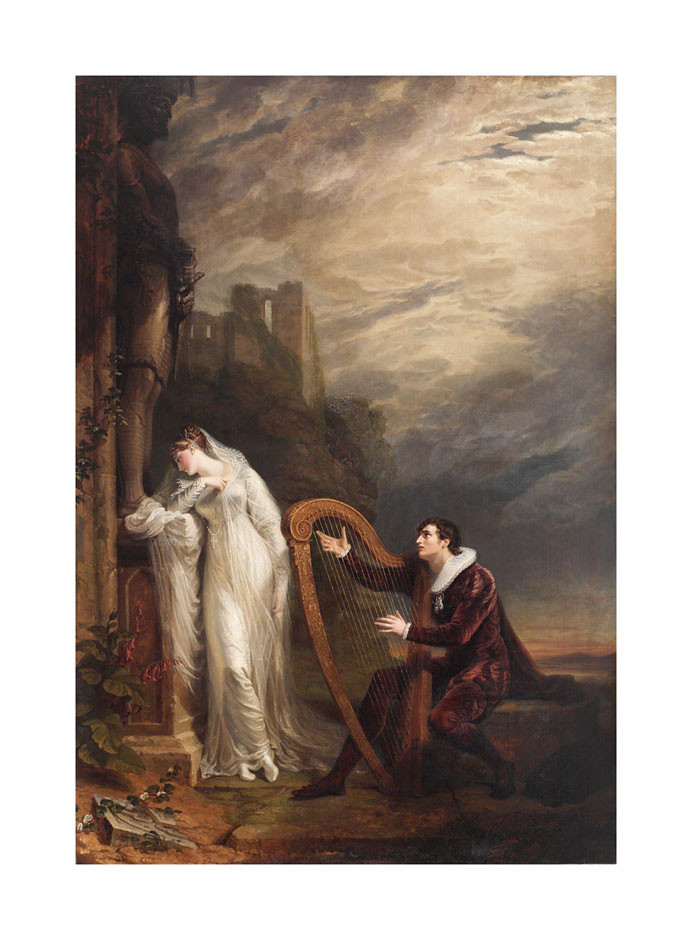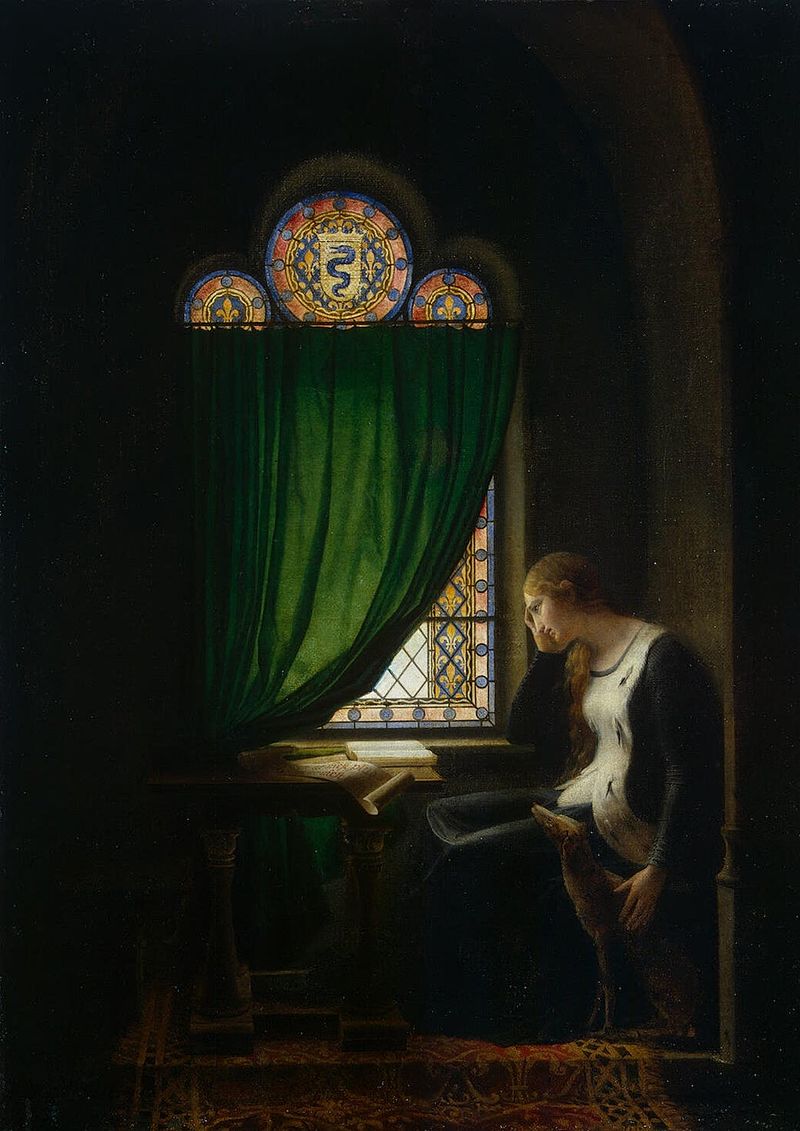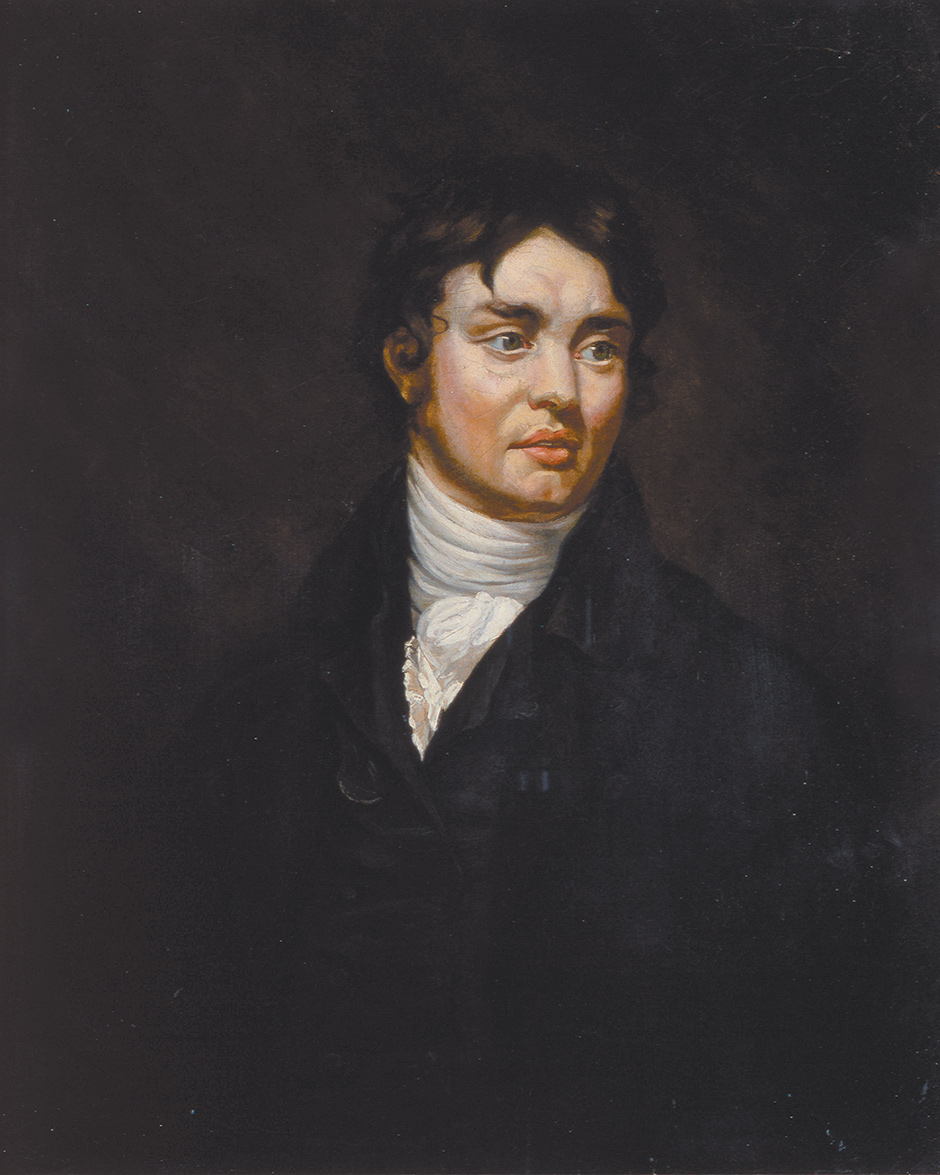
Spoke in her cheeks, and so distinctly wrought,
That one might almost say, her body thought.
- John Donne, Second Anniversary
Te Papa's permanent collection includes an enormous oil painting by the English artist George Dawe called Genevieve (from by a poem by S.T. Coleridge entitled 'Love') that was prominently featured in the 2013 exhibition Angels & Aristocrats. Produced during a period of immense social, political, and cultural upheaval, Dawe's canvas shows the shadow of the past falling over the future. It marks a moment of transition, on the threshold of a new age and a new order, from one social structure to another, during which traditional mores came under tremendous pressure. When it was first exhibited at the Royal Academy two hundred years earlier, the scandalous background to Coleridge's poem was common knowledge among the fashionable literary and artistic circles of the day. Dawe explicitly explored the sexual implications of Coleridge's transgressive behaviour in an era when such risky business was generally either ignored or condemned.
At first glance, Dawe's painting appears to be simply an overblown example of le style troubadour - a sometimes derisive term for French historical painting of the early nineteenth century, given to idealised depictions of the Middle Ages, which has been considered a precursor of the Romantic rebellion against Neoclassicism. Following the Comte de Tressan's adaptation of a number of chivalric romances for his Bibliothèque Universelle Des Romans, published them continuously from 1775-89, this rediscovery of medievalism was one of the intellectual fads of the period. Their illustrated engravings, showing decorated and figured troubadour scenes, were widely circulated, and many other French writers, sensing a commercial opportunity, followed suit.
The Musée des Monuments Francais, established in 1795, preserved relics of French Medieval and Renaissance art that had been removed from churches and chateaux after the Revolution, presenting them as subjects of admiration for the public and models of inspiration for students of engraving, painting, and sculpture.

Fleury Richard's melancholy
Valentine de Milan, the first troubadour painting to
be presented at the Salon of 1802, was inspired by a visit
to the Musée. It was a huge hit and similarly
back-lit compositions, with the foreground in semi-darkness,
became a trademark of the style. In composition as much as
in sentiment, it harks back to the prints illustrating
Tressan's revisions of the chansons de geste. Most of
them represented sentimental anecdotes from French
literature or history and often derived directly from
exhibits in the Musée. These fashionable engravings
provided the basic pattern for pictures of similar themes
produced across Europe and America throughout the nineteenth
century. Fabre d'Olivet's Le Troubadour, Poésies
Occitaniques (1803) popularized the term, and led to the
naming of the genre.
Widespread interest in the Middle Ages had already begun in England in 1764 with the publication of Horace Walpole's Castle of Otranto, which engendered a wave of Gothic novels and fantastical romances so turgid that by 1798 that Jane Austen felt free to satirize them in her first novel Northanger Abbey. Sir Walter Scott began collecting Scottish Border ballads as a young man, and the publication of The Minstrelsy of the Scottish Border in 1802/3 and The Lay of the Last Minstrel in 1805 established his reputation in spectacular fashion. His subsequent Waverley Novels were best-sellers across Europe from 1814 onwards, and highly influential on novelists as diverse as Fenimore Cooper, Alexandre Dumas, and Victor Hugo.
In 1819, John Keats composed La Belle Dame sans Merci (replete with "faery-song," an "Elfin grot", and "pale warriors") and transformed another romance from Tressan's collection into the opulently sensuous Eve of St. Agnes, referring to -
In Provence call'd, 'La belle dame sans merci'.
The sustained influence of this enthusiasm for what was considered the antique authenticity of medieval minstrels, peasants and popular balladry can be traced through the poetry of Tennyson, the paintings of the Pre-Raphaelites, and Pound's rediscovery of Provencal chansons, to the English folk music revival of the 1960s. There are several similarities between medieval and Romantic cults of love, both of which invested the relationship between the sexes with a mystical aura that accounted for the popularity enjoyed by the troubadour ballads and the chansons de geste in the early nineteenth century.
Edmund Burke's theory of the Sublime emphasized this "ruin sensibility" of the Romantics, which sought fulfillment in "dark chasms of the mind and soul where catastrophic desires gape, uneasily and greedily, for fulfillment." The popularity of pictures of this type, which enjoyed worldwide diffusion in prints, derives from that of the historical anecdote, valued for its power to highlight a moment in the past, and appealing to the heart as much as the mind. As illustrations of how people in the past had felt, they all made a strong appeal to sentiment and the historical authenticity of detail suggested that such sentiments were equally true. But beneath the smooth surface lurked the smouldering desires and brooding fears of the Romantics. Sexual frustration, religious doubt, and social insecurity are themes which can hardly be ignored in such pictures. The incidents in medieval literature which held the highest appeal for the Romantics were those describing the infraction of the code of courtly love, such as the Arthurian legend of Launcelot and Guinevere (a name not far removed from Genevieve).
Coleridge's choice of the name Genevieve for his heroine (relatively uncommon in England until the late nineteenth century) not only coincides with this interest in the Antique, but also shares such sententious concerns. Recorded in early medieval records as Genovefa or Genoveva, it is almost certainly Gaulish in origin, but its etymology remains obscure. Coleridge's selection of such an unusual name derives from the medieval legend of Geneviève of Brabant, an archetypal example of the chaste wife falsely accused and repudiated. She was the heroine of a tale from the thirteenth-century Legenda Aurea, a collection of saints’ lives compiled by the Italian monk Jacobus de Voragine, in which she was described as the wife of the Count Palatine, Siegfried of Treves. Treacherously denounced by his majordomo Golo, Geneviève was sentenced to death, but was spared by the executioner and supposedly survived for six years with her son in a cave in the Ardennes, nourished by a white roe. Siegfried uncovered Golo's duplicity and was hunting deer when he came across her hiding place, and reinstated her. This legend may have originated in the historical thirteenth century figure of Marie of Brabant, who was suspected of infidelity by her husband Louis II, Duke of Bavaria, tried, found guilty, and beheaded. When the verdict was proven wrong, Pope Alexander IV commanded Louis to perform penance for her execution by founding Furstenfeld Abbey. The tale was revived in Leben Und Tod Der Heilingen Genoveva, an ambitious and highly popular dramatic poem published by Ludwig Tieck, one of the founders of German Romanticism, in 1799 - precisely the same year that Coleridge composed Love.
Thirteen years later, when Dawe unveiled his canvas to the members of the Academy, the notoriety of the name would have been obvious to an artistic audience caught on the cusp between Neoclassicism and Romanticism. To fully appreciate the alacrity with which this adoption of Romantic precepts in the arts occurred, we need only glance at Turner's landscapes, in which shakily structured figures are thrown, almost as afterthoughts, into vast expanses of space and time by a driven handiwork that seeks to mimic the actions of that cosmic nexus. Or compare Dawe's approach to his seated minstrel with the minuscule, Bon Joviesque figure depicted by John Martin in The Bard, painted barely five years later. Martin's poet perches on a perilous precipice, swallowed up by a Sublime landscape of onrushing torrents, roaring waterfalls, and unattainable mountain peaks.

The Bard - John Martin, circa 1817
In
contrast, Dawe's approach is a model of subtle restraint. He
adorns Coleridge's grave-side ballad of abduction and
potential rape with more muted, formulaic Gothic trappings -
the fragment of ruined castle on the mountain cliff, the
tenebrous and crepuscular clouds at dusk that overshadow
half the picture. Embarrassed by the poet's passionate
effusion, the alabaster-skinned Genevieve averts her head
and blushes deeply, while the bard's hands are delicately
splayed along the diagonal line of the composition, gently
plucking and stroking the strings of his refulgent
instrument. It is no accident that Dawe chooses to
substitute the horizontal Aeolian harp of Coleridge's poem
with the more familiar vertical harp - and nestles it
suggestively between the poet's thighs.
Our eyes follow his imploring gaze across to Genevieve's averted glance and down to the Dark Knight's grave, where Dawe has inscribed his signature among entwined sprigs of elder-bloom and myrtle. Genevieve, clad in a virginal white gown with such a tight bodice that she must find it difficult to inhale, glances away from the poet's impassioned gaze toward the knight's feet, over which she has draped her veil. She literally droops over the tombstone of the Dark Knight, whose immense verticality represents the full weight of tradition in all its condescending, repressive, and overbearing authority. Although the fetishisation of feet is clearly one of Dawe's preoccupations (the lady's are singularly petite, the poet's inordinately large), perhaps the most striking aspect of the canvas is the rich blush of ruby-red that not only suffuses Genevieve's cheeks, but also colours those of her suitor. The beseeching troubadour bears a distinct resemblance to Coleridge, albeit wrapped in elaborate red velvet raiments, replete with anachronistic Elizabethan cape, rebato and lace ruff, and Rhinegraves.
If there is any remaining doubt about Dawe's intent, compare the massive immensity of the bard's gorgeously gilded harp with the stubby metallic handle of the Dark Knight's falchion, positioned equally suggestively at crotch-level. No wonder Genevieve turns her head and glances away, unable to hold the intensity of the balladeer's importuning gaze, as she glows bright as a beetroot. Dawe invokes a whole history of blushing that pivots around a direct connection to sexual arousal and even orgasm. Before exhuming this subtext in more detail, however, it is instructive to outline briefly the historical context within which both artists operated, as well as the significance of the legendary iconography they employed.
Coleridge, Southey, & The Three Saras
Throughout his life, Coleridge often found himself in great physical and mental distress. He suffered from crippling bouts of anxiety and a variety of health problems stemming from rheumatic fever as a child, for which he was treated with laudanum, and which subsequently fostered his addiction to opium. In 1791, he enrolled at Jesus College, Cambridge, but two years later enlisted in the Royal Dragoons under the improbable name of Silas Tomkyn Comberbache. Military life did not suit his delicate temperament and he became severely depressed. His brothers arranged for his discharge a few months later for reasons of "insanity," and he was subsequently readmitted to Jesus, though he failed to complete his studies and never received a degree.

In June 1794 Coleridge
visited Oxford, where he met the poet Robert Southey, whose
radical political ideals inspired him to collaborate on the
creation of a utopian community in America. They were
heavily influenced by recent accounts of the New World and
fascinated by the thought of a fresh and inviting country on
the other side of the Atlantic, whose inhabitants they
imagined were untainted by the evils of society. Coleridge
and Southey decided to establish an egalitarian community on
the banks of the Susquehanna River in Pennsylvania, and
within a few weeks started planning their 'Pantisocracy'
together.
In July, Coleridge went on a walking tour of Wales, corresponding regularly with Southey about their plans. He shared his enthusiasm for Pantisocracy with many people he met along the way, offending several listeners with his radical ideas. During the trip, he also caught a glimpse of his old flame Mary Evans leaving a church in Wrexham, which temporally drove all other thoughts from his mind - he "turned sick and all but fainted away." In August, he rejoined Southey in Bristol, where they became acquainted with a widow whose two daughters were supportive of their scheme. As Southey became romantically involved with Edith Fricker, Coleridge found himself increasingly drawn to her sister Sara.
Although neither possessed sufficient funds, they planned to leave the following year, hoping that wealthier migrants would join them. Returning to Cambridge in September, Coleridge spread word of their plan, envisioning a community that would include "twelve men with their families" who would split the costs, with the wealthier members of the community providing for the less affluent. Among the families who agreed to accompany them were several children and Coleridge worried that they might already be prejudiced by society, possibly corrupting their Pantisocracy.
Coleridge also faced a number of personal challenges in carrying out this utopian scheme. He received a letter from Mary Evans, arguing against their plan and his feelings for her briefly swayed him against it. When he learned she had married, however, Coleridge turned his attention back to both Pantisocracy and Sara Fricker. Pressured by Southey, he married Sara and in November Southey married Edith. But Coleridge rapidly grew to detest his wife, whom he had married mainly because of Southey's insistence, and they soon separated. As their plans bogged down in practical realities, Southey and Coleridge reached an impasse and by the winter of 1795 their project had collapsed.
Such was Coleridge's state of mind - warped by emotional frustration interwoven with adolescent idealism - when he moved into what is now known as Coleridge Cottage in Clevedon. Amidst the stunning Somerset landscape, he was introduced to William Wordsworth and they began to compose most of the poems that became Lyrical Ballads. The following year, they visited Thomas Hutchinson's farmhouse in the village of Sockburn, where Coleridge met Sara Hutchinson, sister of Wordsworth's childhood friend Mary. It was here that he wrote most of his ballad Introduction to the Tale of the Dark Ladie (which later became Love) and addressed it to Sara, whose hair was a beautiful shade of auburn, like Genevieve's in Dawe's painting.
Coleridge rapidly became infatuated with Sara, despite the fact that his wife and three children were living with (and being supported by) Southey on a tiny income in the Lake District, following his abandonment of them. Coleridge had a predilection for falling in love with the sisters of his best friends. It was not coincidental that he should meet the love of his life at the same time that Wordsworth was beginning to think about marrying; both of them had prior romantic relationships that had become untenable. In addition, not only was Coleridge consuming large amounts of laudanum by this time, but both he and Southey were also heavily involved in experiments with nitrous oxide, administered by the famous Cornish scientist Humphry Davy.
Despite all this inner turmoil, Coleridge managed to complete another poem about Hutchinson, sending her a draft in April 1802. Originally entitled Letter to Sara Hutchinson, it became Dejection: An Ode when published in The Morning Post on 4 October - the same day that Wordsworth married Mary Hutchinson, as well as Coleridge's own wedding anniversary. It was grouped with the Asra poems - a series of verses investigating the nature of love that Coleridge dedicated to Hutchinson, lightly disguising her identity with this anagrammatic pseudonym. Since they reflect two distinctly different stages in Coleridge's emotional struggles, several revealing passages about his childhood and other personal matters were deleted. Nine months later, however, Coleridge had second thoughts. He cut off Sara Hutchinson and resumed his relationship with his wife Sara Fricker. In December 1803, she gave birth to another daughter, whom they also decided to call Sara.
Part II continues here -
http://www.scoop.co.nz/stories/CU1712/S00308/sexting-in-george-dawes-genevieve-part-ii.htm …



 Burnett Foundation Aotearoa: S.L.U.T.S Might Be The Answer To Ending Syphilis Outbreak
Burnett Foundation Aotearoa: S.L.U.T.S Might Be The Answer To Ending Syphilis Outbreak Aotearoa Covid Action: Pharmac Urged To Widen Access To Covid Vaccines
Aotearoa Covid Action: Pharmac Urged To Widen Access To Covid Vaccines Howard Davis: Dick Frizzell’s Hastings & Studio International Revisited In Wellington
Howard Davis: Dick Frizzell’s Hastings & Studio International Revisited In Wellington Heritage New Zealand: New Education Resource On Ōtūmoetai Pā Released
Heritage New Zealand: New Education Resource On Ōtūmoetai Pā Released Bowel Cancer NZ: Broken Promise, Lost Lives - Govt’s Bowel Cancer Screening Pledge 98% Undelivered
Bowel Cancer NZ: Broken Promise, Lost Lives - Govt’s Bowel Cancer Screening Pledge 98% Undelivered NZFC: Apply For The New Zealand Film Commission’s He Kauahi Catalyst
NZFC: Apply For The New Zealand Film Commission’s He Kauahi Catalyst 